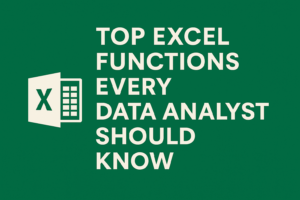In today’s digital world, data is being generated at an unprecedented rate—from social media interactions and online purchases to sensor data and financial transactions. But raw data by itself holds little value. What unlocks its true power is data analytics—the process of examining data to uncover meaningful patterns, trends, and insights.
Whether you’re a business leader aiming to make data-driven decisions or a student considering a career in analytics, understanding the basics of data analytics is essential.
What is Data Analytics?
Data analytics refers to the techniques and processes used to inspect, clean, transform, and model data in order to discover useful information, draw conclusions, and support decision-making. It can be applied across various fields such as marketing, healthcare, finance, logistics, sports, and more.
Why is Data Analytics Important?
- Better Decision Making: Data-driven decisions reduce guesswork and improve accuracy.
- Increased Efficiency: Analytics identifies bottlenecks and improves operational workflows.
- Competitive Advantage: Businesses that leverage data analytics can predict market trends, understand customer behavior, and outperform competitors.
- Risk Management: Detecting anomalies and patterns helps organizations mitigate risks early.
Types of Data Analytics
- Descriptive Analytics:
Focuses on summarizing past data to understand what has happened.
Example: Monthly sales reports or web traffic summaries. - Diagnostic Analytics:
Examines data to understand why something happened.
Example: Analyzing sales dips due to a marketing campaign’s failure. - Predictive Analytics:
Uses statistical models and machine learning to forecast future outcomes.
Example: Predicting customer churn or future product demand. - Prescriptive Analytics:
Suggests actions based on data to achieve desired outcomes.
Example: Recommending inventory restocking strategies based on demand patterns.
Key Components of Data Analytics
- Data Collection: Gathering data from various sources like databases, APIs, surveys, or sensors.
- Data Cleaning: Removing duplicates, correcting errors, and handling missing values.
- Data Exploration: Visualizing data through charts and summary statistics to identify patterns.
- Data Modeling: Applying statistical or machine learning models to analyze or predict outcomes.
- Data Visualization: Communicating insights clearly through dashboards, graphs, and reports.
Popular Tools Used in Data Analytics
- Excel – Great for basic analysis and quick visualizations.
- SQL – Essential for querying relational databases.
- Python/R – Powerful programming languages for data analysis and modeling.
- Tableau/Power BI – Widely used tools for interactive data visualization.
- Google Analytics – Used for website traffic and behavior analysis.
Who Uses Data Analytics?
- Businesses to understand customer behavior and optimize operations.
- Healthcare Providers to improve patient care and resource allocation.
- Retailers to manage inventory and personalize marketing.
- Sports Teams to analyze player performance and strategy.
- Government Agencies to inform policy decisions.
Getting Started with Data Analytics
You don’t need to be a mathematician to start with data analytics. Begin with:
- Learning basic Excel and SQL.
- Understanding key statistics concepts.
- Taking beginner courses on platforms like Coursera, Udemy, or edX.
- Practicing with open datasets (e.g., Kaggle, data.gov).
Conclusion
Data analytics is revolutionizing the way decisions are made. It’s not just about crunching numbers—it’s about extracting insights that can drive impactful change. As the demand for data-literate professionals grows, now is the perfect time to start your journey into the world of analytics.
